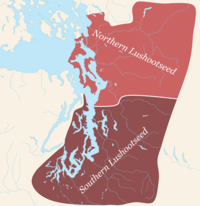Stillaguamish Tribe Of Indians Of Washington
Although the Stillaguamish had existed for thousands of years prior, the Stillaguamish Tribe as it is today was founded on January 31, 1953, when the tribe ratified its constitution. The tribe eventually petitioned for federal recognition in 1974, which they received two years later in 1976. In 2014, the tribe was finally granted a reservation.
The Stillaguamish Tribe is governed by the Stillaguamish Tribal Council, which carries out the administrative duties of the tribe. The tribe operates several businesses and services, both on and off the reservation.
Name
The name "Stillaguamish" is an anglicization of their Lushootseed endonym, stuləgʷabš. The Lushootseed name means "people of the river," from the root word stuləkʷ meaning "river" and the suffix =abš meaning "people." The name stuləgʷabš is a drainage term, referring not to a central village but to all the people living along the Stillaguamish River.
History
In 1855, the Stillaguamish were party to the Treaty of Point Elliott, alongside many other Puget Sound peoples. The Stillaguamish were listed on the treaty as the Stoluck-wa-mish River Tribe. Although the treaty promised the establishment of a Stillaguamish reservation, one was not established until 2014. For this reason, many Stillaguamish remained in their traditional homelands, unrecognized and off reservation lands.
On January 31, 1953, the Stillaguamish Tribe of Washington wrote and approved their constitution, which established a democratically-elected six-member tribal council.
In 1974, the tribe petitioned for federal recognition, which was achieved on October 27, 1976.
In 2014, the tribe owned 64 acres of land, which were recognized as a reservation for the tribe.
Government
The administrative duties of the Stillaguamish Tribe are performed by the Stillaguamish Tribal Council, also called the Board of Directors. The tribal council is composed of six popularly-elected members, including a Chairman, Vice-Chairman, Treasurer, Secretary, and two additional members.
As of September 2024, the membership of the Stillaguamish Tribal Council is as follows:
- Chairman: Eric White
- Vice Chairman: Kadi Bizyayeva
- Secretary: Gary Tatro
- Treasurer: Joshua Wells
- Jeremy Smith
- Stacy White
Language

The language of the Stillaguamish Tribe is Lushootseed, a Coast Salish language spoken by many different tribes throughout the Puget Sound region. Today, English is the more-commonly spoken language by members of the tribe, although the tribe is working to revitalize the language. The Cultural Resources Department of the tribe manages the tribe's cultural elements, including language. They offer classes for Lushootseed, and the tribe has a YouTube channel where they offer resources and lessons in Lushootseed.
Economic Development
The Stillaguamish Tribal Business Development Department develops and works in partnership with the Board of Directors for the tribe's businesses. Businesses operated by the tribe include River Rock Tobacco & Fuel and the Angel of the Winds Casino Resort, all located in Arlington.
Stillaguamish Reservation
The Stillaguamish Reservation was established in 2014 and is composed of several parcels of land, totaling 64 acres.
References
- ^ "Stillaguamish Tribe". Northwest Portland Area Indian Health Board. Retrieved September 16, 2013.
- ^ "About Us". Stillaguamish Tribe of Indians. Retrieved January 23, 2022.
- ^ Bates, Dawn; Hess, Thom; Hilbert, Vi (1994). Lushootseed Dictionary. Seattle: University of Washington Press. ISBN 978-0295973234.
- ^ Smith, Marian W. (1941). "The Coast Salish of Puget Sound". American Anthropologist. 43 (2): 197–211. doi:10.1525/aa.1941.43.2.02a00050. JSTOR 662952.
- ^ Hollenbeck, Jan L. (1987). A Cultural Resource Overview: Prehistory, Ethnography, and History: Mt. Baker-Snoqualmie National Forest. Portland: US Department of Agriculture, Forest Service, Pacific Northwest Region.
- ^ Lane, Barbara (1973). Anthropological Report on the Identity, Treaty Status and Fisheries of the Stillaguamish Indians (PDF).
- ^ "Tribal Government". Stillaguamish Tribe of Indians. June 9, 2023. Retrieved February 26, 2024.
- ^ "Cultural Resources". Stillaguamish Tribe of Indians. Retrieved February 26, 2024.
- ^ "Stillaguamish Tribal Enterprise Corporation." Retrieved September 26, 2013.
- ^ "Angel of the Winds Casino." 500 Nations. Retrieved September 26, 2013.
Further reading
- Esther Ross and the Struggle for Stillaguamish Identity
External links
- Stillaguamish Tribe of Indians, official website
